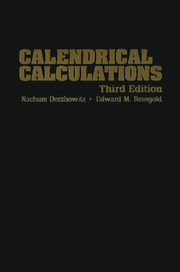Book contents
- Frontmatter
- Dedication
- Contents
- List of Frontispieces
- List of Figures
- List of Tables
- Abbreviations
- Mathematical Notations
- Preface
- Credits
- License and Limited Warranty and Remedy
- About the Cover
- 1 Calendar Basics
- I ARITHMETICAL CALENDARS
- 2 The Gregorian Calendar
- 3 The Julian Calendar
- 4 The Coptic and Ethiopic Calendars
- 5 The ISO Calendar
- 6 The Islamic Calendar
- 7 The Hebrew Calendar
- 8 The Ecclesiastical Calendars
- 9 The Old Hindu Calendars
- 10 The Mayan Calendars
- 11 The Balinese Pawukon Calendar
- 12 Generic Cyclical Calendars
- II ASTRONOMICAL CALENDARS
- III APPENDICES
- Index
- Envoi
- About the Cover
5 - The ISO Calendar
Published online by Cambridge University Press: 05 February 2014
- Frontmatter
- Dedication
- Contents
- List of Frontispieces
- List of Figures
- List of Tables
- Abbreviations
- Mathematical Notations
- Preface
- Credits
- License and Limited Warranty and Remedy
- About the Cover
- 1 Calendar Basics
- I ARITHMETICAL CALENDARS
- 2 The Gregorian Calendar
- 3 The Julian Calendar
- 4 The Coptic and Ethiopic Calendars
- 5 The ISO Calendar
- 6 The Islamic Calendar
- 7 The Hebrew Calendar
- 8 The Ecclesiastical Calendars
- 9 The Old Hindu Calendars
- 10 The Mayan Calendars
- 11 The Balinese Pawukon Calendar
- 12 Generic Cyclical Calendars
- II ASTRONOMICAL CALENDARS
- III APPENDICES
- Index
- Envoi
- About the Cover
Summary
O tempora! O mores! [Oh what times! Oh what standards!]
—Cicero: In Catilinam (63 B.C.E.)The International Organization for Standardization (ISO) calendar, popular in Sweden and other European countries, specifies a date by giving the ordinal day in the week and the “calendar week” in a Gregorian year. The ISO standard [1, sec. 2.2.10] defines the calendar week number as the
ordinal number which identifies a calendar week within its calendar year according to the rule that the first calendar week of a year is that one which includes the first Thursday of that year and that the last calendar week of a calendar year is the week immediately preceding the first calendar week of the next calendar year
This does not define a new calendar per se, but rather a representation of dates on the Gregorian calendar; still, it is convenient for us to treat it as a separate calendar because the representation depends on weeks and the day of the week.
It follows from the ISO standard that an ISO year begins with the Monday between December 29 and January 4 and ends with a Sunday between December 28 and January 3. Accordingly, a year on the ISO calendar consists of 52 or 53 whole weeks, making the year either 364 or 371 days long. The epoch is the same as the Gregorian calendar, namely R.D. 1, because January 1, 1 (Gregorian) was a Monday.
- Type
- Chapter
- Information
- Calendrical Calculations , pp. 79 - 82Publisher: Cambridge University PressPrint publication year: 2007
- 1
- Cited by



